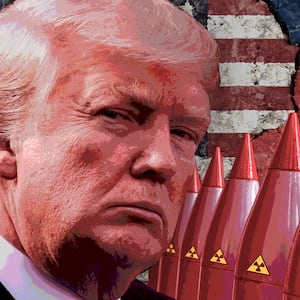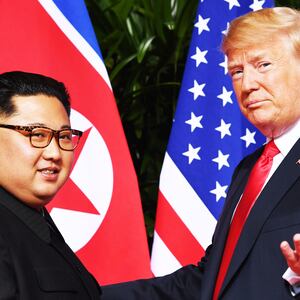Five months after President Trump declared in a tweet that the North Korea nuclear crisis was over, the regime of North Korean leader Kim Jong Un is likely still building new atomic weapons.
Pyongyang apparently is producing, at facilities across North Korea, additional warheads plus missiles capable of delivering them.
In a report published Monday, the Center for Strategic and International Studies, a Washington, D.C., think tank, used commercial satellite imagery and interviews with North Korean defectors and government officials to identify what it described as 13 previously secret missile facilities.
ADVERTISEMENT
Seven more facilities remain hidden, according to the report. A U.S. State Department spokesperson told The Daily Beast the department could not comment on the CSIS report because of the Veterans Day holiday.
At these sites and others, the North Koreans “continue to improve their [nuclear] materials, improve their operational ballistic-missile capability and probably also produce more nuclear warheads,” Daryl Kimball, a nuclear expert at the Arms Control Association in Washington, D.C., told The Daily Beast.
The New York Times described the missile bases’ existence as a “great deception” on the part of North Korea. But that characterization is wrong, experts told The Daily Beast.
In fact, experts said Pyongyang is doing exactly what it said it would do, and which it never promised to stop doing—develop and field a nuclear arsenal. “There is no agreement as yet between the U.S. and North Korea on denuclearization,” Kimball pointed out.
In July 2017, North Korea tested for the first time a long-range rocket capable of delivering a nuclear warhead to the continental United States. And in September of that year, the Kim regime triggered its sixth underground atomic test-blast.
In response, U.S. Defense Secretary James Mattis warned of a potential “massive military response.”
After more than a year of escalating mutual threats, in early 2018 Trump and Kim agreed to meet. As a prelude Kim released American hostages, and just after the Singapore summit, in a show of good faith, Trump halted a major military exercise with South Korea.
Back in Washington, Trump told reporters the nuclear issue was taken care of. Contrasting his own efforts with those of President Barack Obama, he said: "I have solved that problem. That problem is largely solved."
Meanwhile, North Korea had paused flight-testing of long-range missiles as well as underground atomic testing. But not because of anything Trump did or threatened to do, explained Jeffrey Lewis, a nuclear expert at the Middlebury Institute of International Studies at Monterey and the author of the speculative novel The 2020 Commission Report on the North Korean Nuclear Attacks Against the United States.
“At the beginning of the year, Kim Jong Un gave a speech in which he clearly said that North Korea had completed the research-and-development phase of its nuclear and missile programs, and would now shift to what he called ’mass production’ of nuclear-armed systems,” Lewis told The Daily Beast.
In June, Trump met Kim in Singapore for a carefully staged photo-op. The two leaders signed a document pledging to work toward “a lasting and stable peace.” But they did not agree to a substantive plan for ending Kim’s nuclear-weapons production and eliminating its existing arsenal of around 50 warheads plus the medium- and long-range missiles that can carry them.
That didn’t stop Trump from declaring victory shortly after returning from Singapore. “There is no longer a Nuclear Threat from North Korea,” Trump tweeted.
Trump’s announcement either was a lie or reflected a profound misunderstanding on the president’s part of Kim’s plans and promises. Since Kim never agreed to dismantle his nuclear program, the secret missile bases CSIS revealed—and North Korea’s continuing production of atomic warheads and nuclear-capable rockets—are “no surprise to anyone,” Lewis said.
“Kim didn’t deceive anyone,” Lewis added. “Trump deceived himself.”
There’s still an opportunity for a meaningful effort to denuclearize North Korea. Kim wants a formal end to the official state of war that has existed between North Korea and United States since the end of the Korean War in 1953.
“That costs us nothing,” Kimball said, although some analysts worry a peace declaration will lead to demands for the withdrawal of tens of thousands of American troops from the Korean peninsula. In exchange, Kim might agree to discuss a rollback of his country’s atomic capabilities. But only if Pyongyang gets concessions in return—in particular, relief from crippling economic sanctions.
“The North Koreans have been asking for, calling for, corresponding steps by the United States on ending hostilities and arriving at some kind of peace regime,” Kimball said. “They haven’t gotten what they wanted, so they’re going to continue to improve what they see as their deterrence capabilities.”
“That’s what makes the diplomacy that has been sputtering since Singapore so important,” Kimball added. “It’s what makes progress.”







